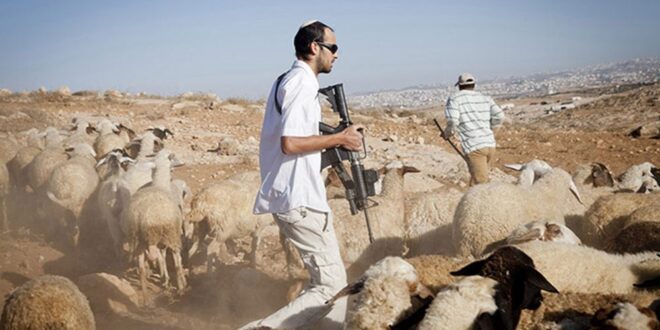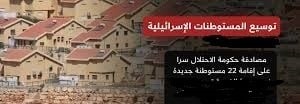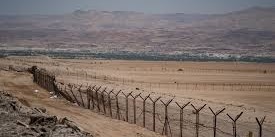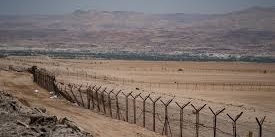By: Madeeha Al-A’raj
The National Bureau for Defending the Land and Resisting Settlements stated in its latest weekly report , that in his latest provocative and aggressive measures, Minister of Finance and Minister of Settlements in the Ministry of the Army, Smotrichsummarized the policy of the 37 Israeli government, the most right-wing and extreme in the history of the occupying state, as follows, “the Palestinian Authority will be changed, ignoring the broad international recognition of the State of Palestine, adding we threw the concept of a Palestinian state to the dustbin of history. Since the beginning of the war, we have frozen NIS 2 billion of the Authority’s funds, and I was able to obtain American support for the matter, and we changed the Israeli control system over the Authority’s banks. Also, we have built 15 new settlements in the West Bank, and we approved the construction of 21,000 new building units.”
“Moreover, we changed the settlement infrastructure related to the law, property rights, and legal conditions. We changed the entire occupation regime in the West Bank, as we declared 26,000 new dunams as state land, and decided to spend NIS 7 billion on the streets of settlers. We transferred all of Area B in the Jerusalem desert to Israeli authorities to carry out demolition operations, and we will demolish buildings in Area B. We declared Israel’s control over the West Bank without officially declaring its annexation, and I convinced Netanyahu of the plan to strengthen government control on the West Bank, we were forced to engage in difficult conflicts with the army and the judiciary. We have become very close to a model for legitimizing settlement outposts in the West Bank.”
“Within a few months, we will be able to create a model that allows settling the legal status of the majority of settlement outposts in the West Bank. We have formed a separate civilian body within the Ministry of Defense to give the impression that control On the West Bank, there will be no government. We are on our way to increasing settlements, and our plan aims to prevent the establishment of a Palestinian state that would endanger the existence of Israel.”
Over the past few days, leader of Religious Zionism was the star of news of thieves seizing the lands, property, and money of the Palestinian people. He bragged about the legalization of a number of settlement outposts and praised what he called the pioneering work carried out by the settlers in what is called pastoral settlement and the expansion of establishing pastoral farms as the best means. Seizing Palestinian lands, as the period since the formation of the current Israeli government has witnessed the establishment of 29 settlement outposts, including 14 outposts and pastoral farms since the outbreak of the war on Gaza on Oct. 8, the last of which was 4 settlement outposts on Palestinian land in the town of Sinjil in the Ramallah and Al-Bireh Governorate at Ein Al-Sakot in the northern Jordan Valley and Al-Marajat to the north of the city of Jericho, and the Khallet Al-Nahla area near Wadi Rahhal, south of Bethlehem.
Last August, the “Times of Israel” website revealed details of a plan adopted by the leader of religious Zionism to legitimize 155 random settlement outposts, including a large number of pastoral farms in which extremist terrorists live on the outskirts of Palestinian population and Bedouin communities, whose function is to work to displace the residents of these communities.
What is the pastoral farms, who finances and directs them and their activities? It is not a new phenomenon, but rather an old one adopted by the Zionist movement even during the time of the British Mandate over Palestine. A farm or pastoral settlement is established through the control of an individual settler, or a group of Hill youth thugs i.e. “the nom de guerre of terrorist price tag organizations”, over an area or one or two or more mountains for raising livestock. According to Zeev Hefer, Director General of the Amana Settlement Association, this model can control thousands of dunams quickly compared to traditional methods that require bureaucratic procedures, meaning that pastoral settlement is based on a strategy of “seizing” large lands and turning them into “used space.” by the Jews, and then linked to the settlement infrastructure e.g. streets, water, electricity, lighting, internet)
In this way, these thugs, mostly organized into settlement associations, have so far seized 350,000 – 380,000 dunums or about 10% of the area of the West Bank, which is larger in area as “a structural plan” than the entirety of the currently existing settlements that have been controlled. The Guardians of Judea and Samaria organization alone adopts about 30 of these farms, and many of these pastoral farms are controlled and managed by 4-8 individuals. The settlement organization “Amana” provides support for these settlement farms. The Ministries of Agriculture and Finance also provide generous funding and legal sponsorship. This phenomenon is expanding and polarizing, and some of the farms are being legitimized as official settlements these days, in clear exploitation of the world’s preoccupation with the brutal war on the Gaza Strip.
These pastoral farms can be classified “settlement nuclei” according to the identity of those who occupy them. There are “biblical” pastoral settlements, which are usually located between Palestinian cities or villages, and are fully protected by the occupation army, such as “Megd Ha’aretz” on the lands of the village of Shufa in Tulkarm Governorate. The “Bar Youssef” farm is on the lands of Kober in the Ramallah and Al-Bireh Governorate, the “Returning to the Country” farm is on the lands of the village of Deir Istiya in the Salfeet Governorate, and the “Tom’s Winery” farm is on the lands of Khirbet Yanun in the lands of the Aqraba town in the Nablus Governorate. There are also pastoral farms for the Hill Youth or “price tag” terrorist organizations, a large number of which are located along the 60 settlement road, which separates the cities of Ramallah, Nablus, and Hebron from the Jordan Valley areas, where these people live, who are usually defined in official Israeli institutions as “young men in Distress: “They need educational programs to integrate them into social life.”
These pastoral farms i.e. “settlement outposts” are under the combined sponsorship of the state and a number of ministries and settlement councils, such as the Shomron Settlements Council “north of the West Bank”, the Benjamin Settlements Council “Jerusalem and Ramallah Governorates”, the Baqaat Herden Regional Council in the northern Jordan Valley, the Megilot Settlement Council in the Southern Jordan Valley, and the Gush Etzion Regional Council on the lands of the Jerusalem, Bethlehem, and North Hebron governorates and the Mount Hebron Regional Council, in addition to sponsoring settlement organizations and associations, most notably the “Guardians of Judea and Samaria,” the “Amana” settlement movement, the Nahala settlement movement, the Um Tristo organization, the Kedma Association, the Aretzino Association, All of them are registered as civil society organizations in Israel.
The Occupying State is considered the most important sponsor of these pastoral farms, as many ministries sponsor them and provide them with funding and protection. The most important ministries that fund pastoral settlement directly are the Ministry of Agriculture and the Ministry of Education through the preparation of what it calls rehabilitation programs for biblical youth, and the Ministry of the Army through the Settlement Department, which it heads. Israel Yehuda, one of the founders of the Regavim organization and Smotrich’s right-hand man, and through the Civil Administration, whose deputy head is the settler Hillel Root, who is also close to Minister Smotrich.
In a remarkable development, the occupying state completed procedures last week to confiscate 24,000 dunums in the Jordan Valley area in the occupied West Bank by classifying them as “state land” in preparation for establishing settlement projects there. This came in three stages. The first stage was during the term of the previous government headed by Naftali Bennett, during which 3,500 dunams were confiscated, four months ago, 8,500 dunums and last week another 12,000 dunums, according to the Ynet website.
The Israeli plan calls for the construction of settlement housing units and industrial and commercial areas in these lands, and it is expected that the “Supreme Planning Council” of the “Civil Administration” for the occupation will pay for the construction of 5,300 settlement housing units in this area, and about 600 other housing units to be marketed in other areas in the West Bank, after 152 housing units were approved in the “Negohot” settlement in the Hebron area, 260 housing units in the Jordan Valley settlements, and 140 housing units in the settlement. “Kiryat Arba”, and 186 housing units in the “Elon Moreh settlement” near Nablus. The goal is to prevent Palestinian geographical continuity on the one hand, and establish Jewish settlement continuity on the other hand.
On the agenda of the Supreme Settlement Planning Council are plans to build 6,016 settlement units in dozens of settlements in the West Bank. According to what is leaking in the Israeli media “Yedioth Ahronoth”, the size of the settlements is expected to increase by 10 percent. For example, “Alon Shavuot,” located southwest of Jerusalem, which currently includes only about 60 housing units will be approved for more than 1,000 new residential units. The council’s plans also include building a new neighborhood in the Yakir settlement, northwest of Salfit, across the road leading to the settlement. At the same time, approval was made for the construction of 152 housing units in the Nagohot settlement in Mount Hebron, 260 other units in the Jordan Valley settlements, 140 units in Kiryat Arba in Hebron, and 186 units in Alon Moreh, east of Nablus. Hundreds of units were also announced in settlements of Machan Gadi, the Booster neighborhood in Negohot in the south of the West Bank, Hogla, and Haltz in Gush Etzion.
At the same time, Smotrich seeks to declare private Palestinian-owned lands that were seized by settlers and where they established the random settlement outpost “Eviatar,” and to transform them into “state lands” after confiscating them from their Palestinian owners, in addition to the confiscation of private Palestinian-owned lands on which other settlement outposts were built, namely “Sadi Ephraim” and “Givat Assaf” in the Ramallah area, “Haletz” between Hebron and Bethlehem, and “Adorim” in the Hebron area, besides approving the building plans Settlement settlements are part of Smotrich’s plan for Israeli “complete control” of the West Bank after the powers of the judicial advisor were transferred to the “Civil Administration” to another judicial advisor in the Ministry of Security, who is under the command of Smotrich, who is working to accelerate the legalization of more settlement outposts and pastoral farms and implement a plan to expand streets throughout the West Bank to serve settlements and settlement activity.
Furthermore, Smotrich is doing his utmost to activate the Supreme Planning Council in order to approve 1000s of housing units in West Bank and to marketing others. Knowing that, since he assumed his position as Minister in the Ministry of the Army, about 21,700 settlement units have been approved, and about 2,600 have been approved for marketing, in total, more than 24,000 units have been approved within a period a year and a half. For comparison, in all years from 2020 until the end of 2022, i.e. 3 years, less than 20,000 housing units were approved.
As part of the directions presented on the urgent agenda of the Supreme Planning Council, Smotrich is pressing for approval of a number of plans to organize what he calls young settlements “pastoral farms” and turn them into settlement nuclei such as Gedi Camp, Beit Hagla “Kedem Arava”, Gevaot, and Webster Neighborhood in Njohot. Among other things, in order to approve construction plans in Elon Moreh “186 housing units” in the Nablus Governorate and Kiryat Arba “more than 240 housing units” in the Hebron Governorate, as well as adding 435 new housing units to the Neria settlement “Talmon B” and doubling the settlement located in Ramallah and Al-Bireh Governorate.
List of Israeli Assaults over the Last Week Documented by the National Bureau:
Jerusalem:
- Forcing Jerusalemite citizen, Abdullah Abu Sbitan, to self-demolish his house, under the pretext of not licensing to avoid paying the demolition costs if the municipality’s crew did., which has an area of 85m2 in the town of Al-Tur, after the occupation court issued a decision to demolish it within 2 days,
- Demolishing another house belonging to citizen Hamdan Siam in the Wadi Al-Joz Neighborhood, under the pretext of not having a license.
Hebron:
- Attacked citizens in the village of Um al-Khair and sprayed them with pepper gas, causing a number of citizens to suffer burns in the eyes and cases of suffocation. The attack came hours after a diplomatic delegation from Belgium, Canada, Denmark, the European Union, Finland, France, Germany, the Netherlands, Sweden and the United Kingdom visited the village to see the conditions there after the demolition of a large number of its homes.
- Demolishing 9 tents and tin homes belonging to citizens Youssef Al-Hanjouri, Ali Al-Qadi, Youssef Al-Ajlouni, Anas Burgan, Ismail Muhammad Burgan, Fayez Al-Faqir, Asaad Yousef Burgan, Yaqoub Ishaq Burgan, and Saeed Burgan in the village of Birin, east of Hebron, even though, they s are located in Area C, where the occupation authorities prohibit construction or land reclamation.
- Injuring citizens in a large-scale settler attack on “Khallet al-Dabaa” in Masafer Yatta, which lasted for 7 hours and began by firing live bullets at citizens’ homes after burning vast areas of citizens’ fields and fruit trees in that area, and preventing civil defense crews from reaching the area. They also burned two houses and smashed the windows and doors of most other houses, in addition to destroying a number of citizens’ vehicles and destroying all the solar energy cells that the people depend on to generate electricity, stole more than 80 sheep.
- Firing live bullets at the citizen, Moh’d Muslim Abu Al-Kabash, 25, while he was herding sheep, wounding him in the shoulder and transporting him to Yatta Governmental Hospital.
Bethlehem:
- Attacking the Al-Khader town, uprooted a grape vineyard in the “Dhahr Al-Ziyah” area belonging to the citizen Moh’d Fawzi Al-Ziyah, and uprooted more than 200 iron corners from the grape vines. Settlers also set up a tent and raised the flag of the occupying state on the lands of the “Jabal Abu Zeid” area, south of the village of Artas, in a move aimed at seizing citizens’ lands in preparation for establishing a settlement outpost.
- Handing over orders to demolish d a kindergarten with an area of 110m2, and to stop construction in a park in the Old City in the village of Al-Jabaa, southwest of Bethlehem, under the pretext of not having a license. Citizen Fatima Zarina was notified of the demolition of her house in the Beir Ona area in Beit Jala and the cessation of construction on two houses, in the Al-Sarj area in the village of Al-Walaja, northwest of Bethlehem, one of which is inhabited and belongs to the citizen Shadi Hajajleh, and the other under construction belongs to the citizen Sami Abu Al-Tinman under the pretext of building without a license.
- Demolishing an agricultural room, bulldozed a piece of land, and uprooted dozens of olive seedlings in the “Rabi’a” area and the homes of the two brothers, the martyr Muhammad Issa Zawahra and the wounded Kazem, in the village of Beit Ta’amr, east of Bethlehem.
Nablus:
- Setting fire to the lands of the town of Beit Furik, east of Nablus, in the western area of the town, while others from the “Yitzhar” settlement launched a large-scale attack on the villages of Madama and Asira al-Qibliya, during which they set fire to large areas of agricultural land, closing the area, raided many homes, seized surveillance camera recordings, detained citizens, and interrogated them on the ground. The Red Crescent Society reported that its crews dealt with injuries in Asira Al-Qibliya, indicating that one of the injured was severely beaten by settlers, while two other young men were injured by settlers’ stones.
- Chopping dozens of trees belonging to Maqboula Nasrallah Othman in the Majdal Bani Fadel village.
- Demolishing 2 houses under construction under the pretext of being built without a license after they stormed the village of Yatma, south of Nablus, accompanied by 2 bulldozers under the pretext of not having a license, belonging to citizens Moh’d Shehada Najjar and Baraa Shehada Najjar.
- Demolishing 2 houses made of tin and briquettes belonging to the family of Sidqi Hamad’s sons in Khirbet Al-Tawil.
- Assaulting a young man by beating him, leaving him with bruises in Jabal Subeih in the town of Beita.
Salfeet:
- Notifying citizens to evacuate the “Bir Abu Ammar” area in the town of Qarawat Bani Hassan, which is considered a park for the towns, and a place for horse racing and youth sports activities, and there is a water spring used to water livestock. They also stormed the house of citizen Rizq Marai in the Al-Tal area, north of the town, and tampered with its contents. They detained him for more than an hour, accompanied by a number of workers who were working in the house’s garden. Then they vandalized the garden, seized the equipment and tools they were working with, and withdrew from the place.
Jenin:
- Attacking citizens’ homes in Al-Fandakumiya, Wasila Al-Dhahr, south of Jenin, and burned large areas of land planted with olive trees and fruit trees, and a house and vehicle belonging to the citizen Muayad Hussein Qariya. They also attacked citizens’ homes, firing live bullets at them and throwing stones at them, at a time when the occupation forces fired poison gas bombs at them.
- Attacking homes of citizens in the town of Silat al-Dhahr, adjacent to the “Homesh” settlement, with live bullets, including the home of citizens Firas Othman Musa and Mukhtar Abu Asba, injured Moh’d Basil Shehadeh in the limbs during the attack
Jordan Valley:
- Storming the Mlihat Arab Gathering in Al-Marajat, threatened the residents and demanded that they leave the area on pain of losing their lives. They burned agricultural crops, including wheat and barley, hours after they set fire to lands adjacent to the Al-Marajat Road, northwest of Jericho.
- Demolishing a house belonging to the citizen Khalil Musa Jahalin in the village of Al-Jiftlik, with an area estimated at 130m2 that houses 10 people. They also demolished a two-story building under construction in Al-Auja belonging to the citizens Tayseer, Jasser, and Ghaleb Nujoom, while settlers threw waste into the stream of Al-Auja Spring, with the aim of polluting it and depriving Palestinians of benefiting from it.
- Storming the Ras Ein-Auja Bedouin community, accompanied by dozens of sheep and camels, and their drilling machines began opening a road in an area adjacent to the community.
- Demolishing a three-room house with an estimated area of about 130m2, belonging to the citizen Saeed Mohammad Rashayda, houses 10 individuals, and leveled a building belonging to the citizen Imad Musa Nawawara. They also notified the cessation of work on residential facilities in Khirbet Humsa in the northern Jordan Valley belonging to the brothers, Yasser and Abdullah Abu-Kbash.
 المكتب الوطني للدفاع عن الارض ومقاومة الاستيطان منظمة التحرير الفلسطينية
المكتب الوطني للدفاع عن الارض ومقاومة الاستيطان منظمة التحرير الفلسطينية




